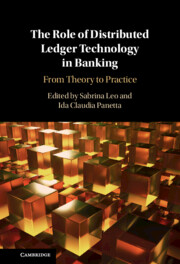Book contents
- The Role of Distributed Ledger Technology in Banking
- The Role of Distributed Ledger Technology in Banking
- Copyright page
- Dedication
- Contents
- Figures
- Tables
- Boxes
- Contributors
- Acknowledgements
- Introduction
- Part I Why Pay Attention to Distributed Ledger Technology in Banking?
- Part II Opportunities and Challenges in Crypto-Asset Regulation
- 3 Some Reflections on the Proposed MiCA Regulation
- 4 Crypto-Assets in Banks
- 5 Cyberlaundering, VASPs’ Regulation, and AML Policy Response
- Part III The Power of Distributed Ledgers in Payments
- Part IV Enabling Financial Inclusion and ESG with Distributed Ledger Technology
- Part V A Further Look at DLT in Banking: Lessons Learned, Current Applications, and Future Scenarios
- Index
- References
4 - Crypto-Assets in Banks
Between Opportunities and Legal Uncertainties
from Part II - Opportunities and Challenges in Crypto-Asset Regulation
Published online by Cambridge University Press: 26 October 2023
- The Role of Distributed Ledger Technology in Banking
- The Role of Distributed Ledger Technology in Banking
- Copyright page
- Dedication
- Contents
- Figures
- Tables
- Boxes
- Contributors
- Acknowledgements
- Introduction
- Part I Why Pay Attention to Distributed Ledger Technology in Banking?
- Part II Opportunities and Challenges in Crypto-Asset Regulation
- 3 Some Reflections on the Proposed MiCA Regulation
- 4 Crypto-Assets in Banks
- 5 Cyberlaundering, VASPs’ Regulation, and AML Policy Response
- Part III The Power of Distributed Ledgers in Payments
- Part IV Enabling Financial Inclusion and ESG with Distributed Ledger Technology
- Part V A Further Look at DLT in Banking: Lessons Learned, Current Applications, and Future Scenarios
- Index
- References
Summary
Crypto-assets, such as cryptocurrencies and tokens, offer a diverse range of payment and investment services. Particularly, tokenisation simplifies products and processes, making negotiation and exchange easier and reducing inefficiencies and costs. However, this disintermediation does not necessarily reduce the role of banks, but rather transforms it, as the increasing complexity of products and services increases the importance of high-value consulting services. Banks can benefit from entering the distributed ledger technology (DLT) ecosystem and can serve as a reliable reference point for investors, consumers, and issuers. However, banks are also exposed to compliance and reputational risks that can only be managed with clear regulation. Regulatory uncertainty, stemming mainly from confusion regarding the legal classification of crypto-assets, hinders the provision of services by banks, and increases risks for consumers and investors. The regulatory framework should be revised in a technology-neutral manner to address these issues and allow for experimentation of innovative solutions, such as the European MiCAR.
- Type
- Chapter
- Information
- The Role of Distributed Ledger Technology in BankingFrom Theory to Practice, pp. 90 - 113Publisher: Cambridge University PressPrint publication year: 2023

